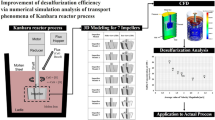Abstract
Nowadays, most steelmaking plants still rely on manual experience to perform Kambara Reactor (KR) desulfurization, which makes it difficult to accurately control the endpoint [S] content for different steel grades, and can easily cause the waste of resources. To achieve cost reduction and efficiency increase, a KR desulfurization process model with production rhythm as the core was developed. The model included three desulfurization modes based on different requirements, namely process priority, time priority, and desulfurizer priority. The self-learning function to regress historical data of past heats was used in the modes of time priority and desulfurizer priority to obtain process parameters, while the process priority mode calculated process parameters just in the dependence of working conditions of current heat. After applying the developed model in a steelmaking plant, the average consumption of desulfurizer decreases from 6.41 to 5.27 kg/t. The one-time hit ratio of desulfurization pretreatment increases from 96.47 to 98.63%.
Access this chapter
Tax calculation will be finalised at checkout
Purchases are for personal use only
Similar content being viewed by others
References
Zhao W (2013) Comparison of desulphurization processes of injection and KR method. Metall Equip 204:86–88
Ji JH, Liang RQ, Feng YT et al (2012) Study on the characteristics of fluid flow in stirring vessels of new type stirring of KR desulphurization. J Iron Steel Res S1:171–174
Wang XH (2007) Iron and steel metallurgy–steelmaking. Higher Education Press, Beijing
Qin ZH, Chen XL (2017) Production practice of reducing KR desulfurizing agent consumption in steel. Wisco Technol 55(2):16–18
Yan XB, Zhao XD, Zhang LG et al (2017) The study of economical desulphurizer consumption computational model utilized on KR desulfurization process. In: Proceedings of the 11th China steel annual conference, Beijing
Song JS, He HL, Liu PF et al (2019) Development of model with deep immersion for desulphurization by KR method in Ansteel and application of the model. Angang Technol 3:22–25
Xu CC, Wang AJ, Liao LH et al (2013) Application of KR hot metal desulfurization technology and one key desulfurization. Wisco Technol 51(2):17–20
Zhou JF, Peng JY, Cheng ZQ et al (2022) Study on water model test of KR stirred hot metal desulfurization. Steelmaking 38(5):10–15
Author information
Authors and Affiliations
Corresponding author
Editor information
Editors and Affiliations
Rights and permissions
Copyright information
© 2024 The Minerals, Metals & Materials Society
About this paper
Cite this paper
Zhu, G., Gao, P., Yang, J., Chen, B., Zhao, X. (2024). Development of the KR Desulfurization Process Model Centered on Production Rhythm. In: Wagstaff, S., Anderson, A., Sabau, A.S., Iloeje, C. (eds) Materials Processing Fundamentals 2024. TMS 2024. The Minerals, Metals & Materials Series. Springer, Cham. https://doi.org/10.1007/978-3-031-50184-5_3
Download citation
DOI: https://doi.org/10.1007/978-3-031-50184-5_3
Published:
Publisher Name: Springer, Cham
Print ISBN: 978-3-031-50183-8
Online ISBN: 978-3-031-50184-5
eBook Packages: Chemistry and Materials ScienceChemistry and Material Science (R0)




